Symmetry in Physics
Page Biersdorff and Laura Jeanty
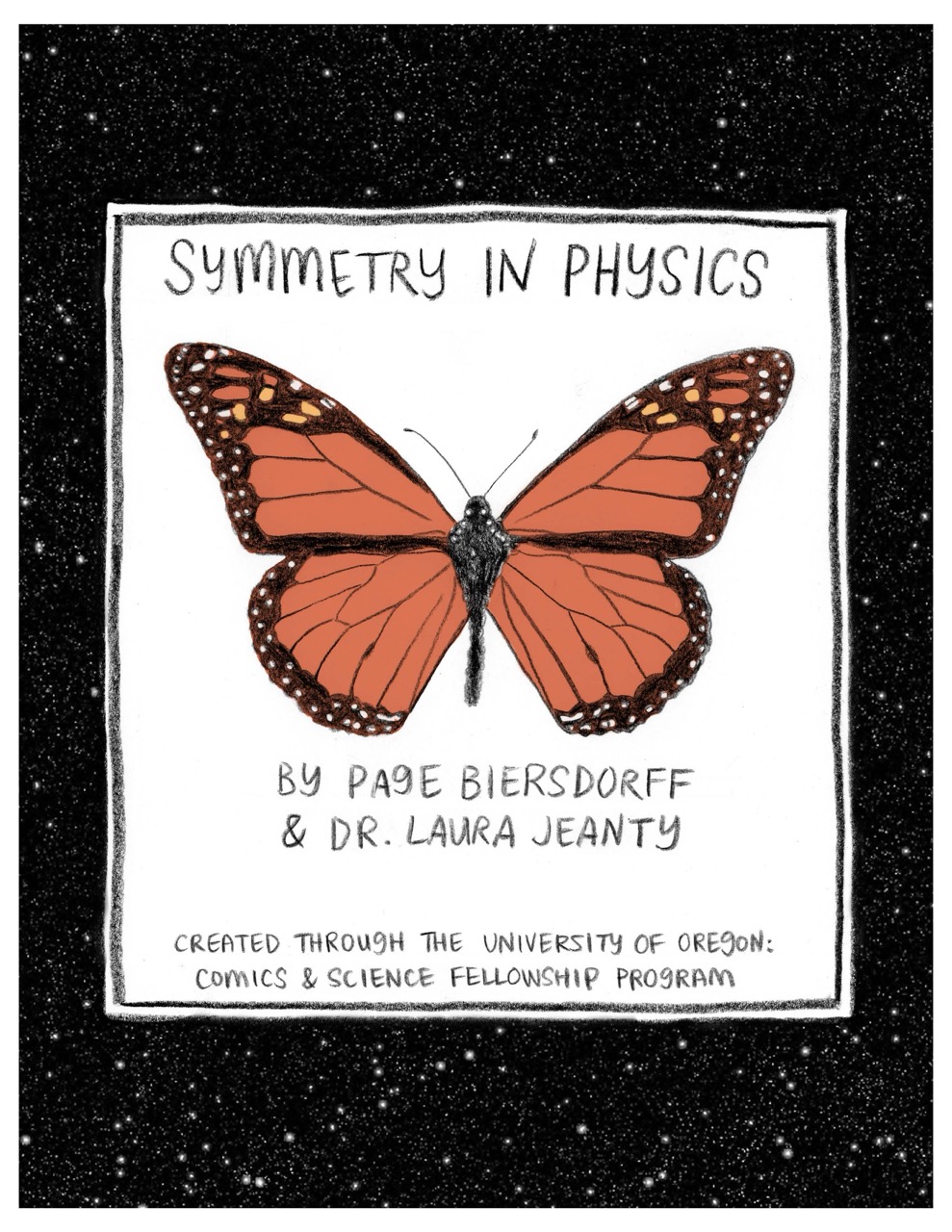
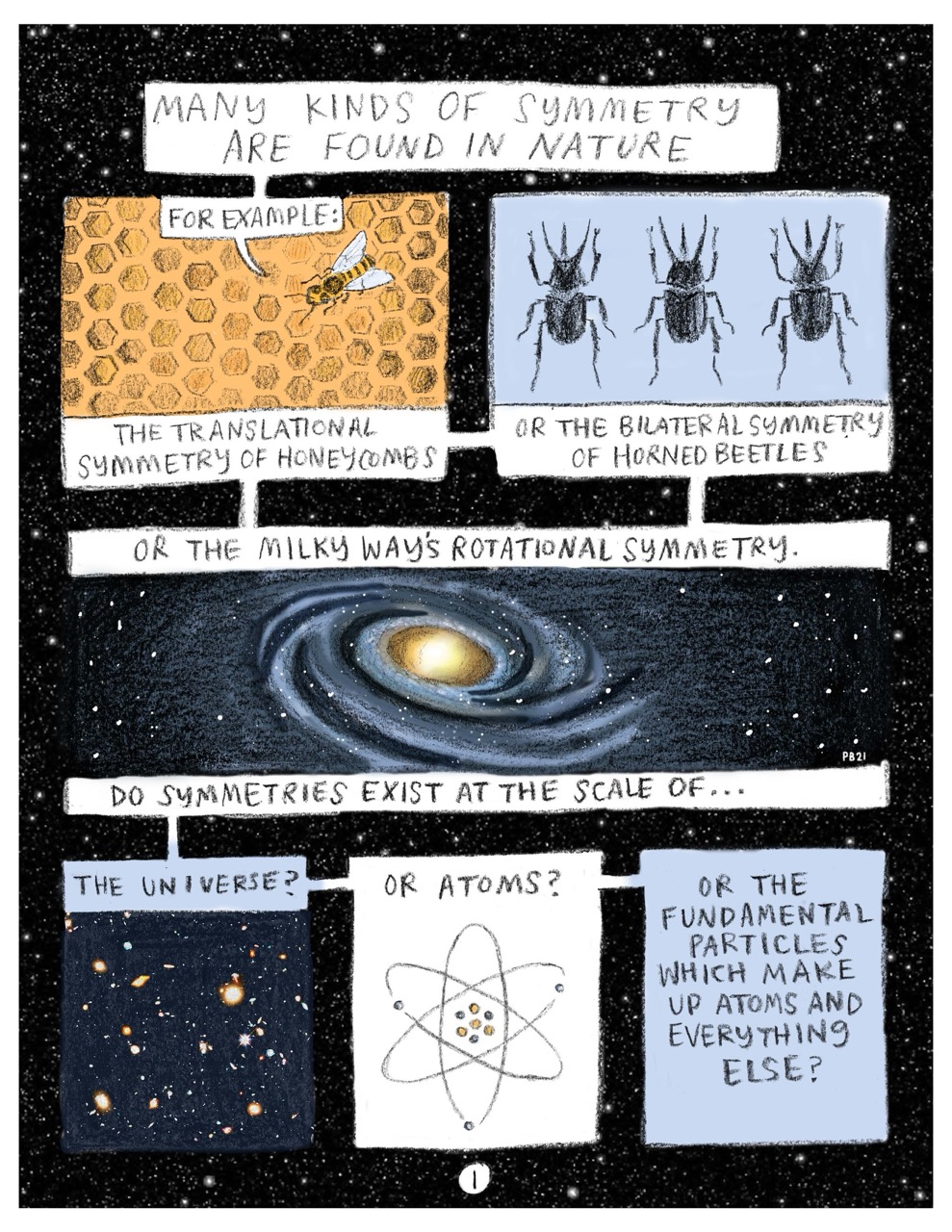
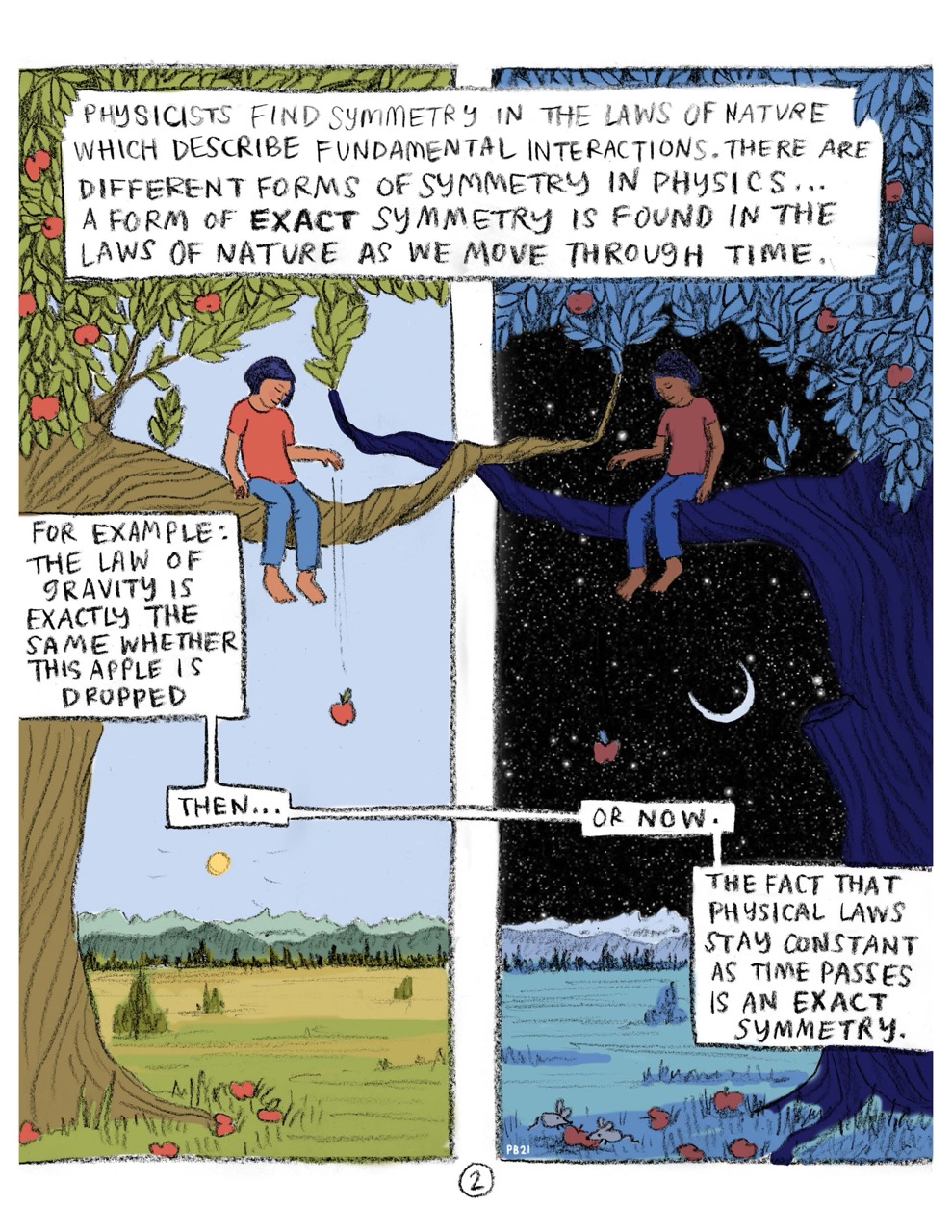
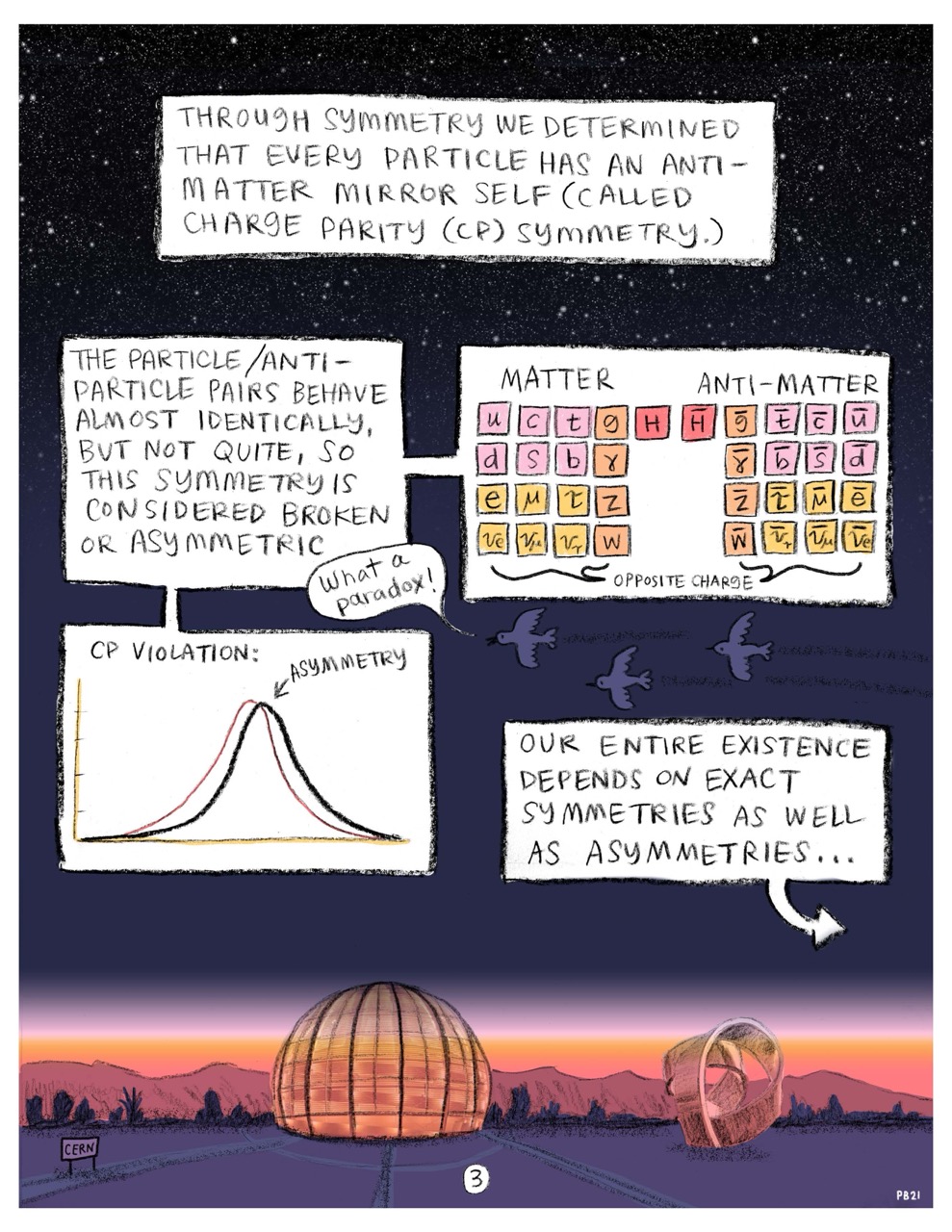
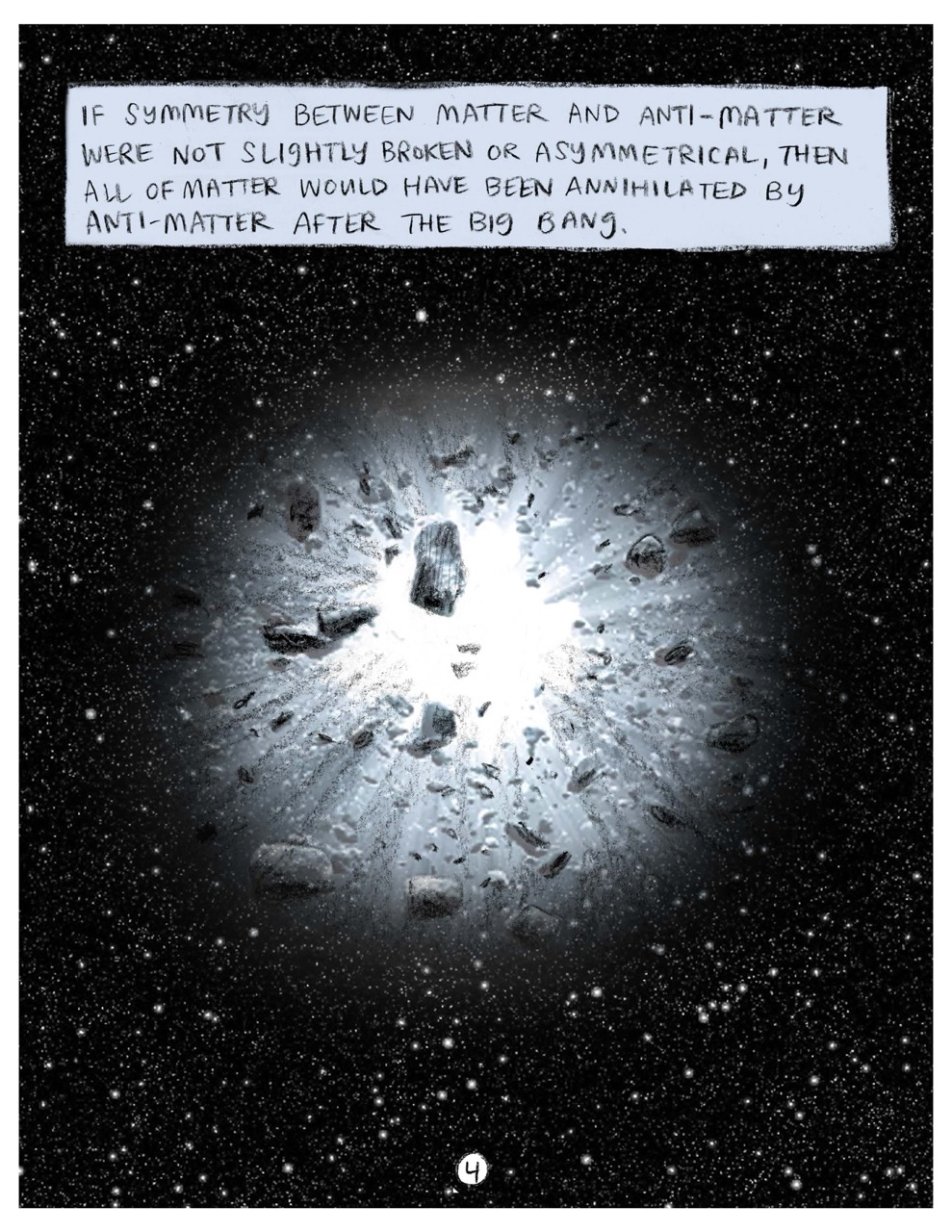
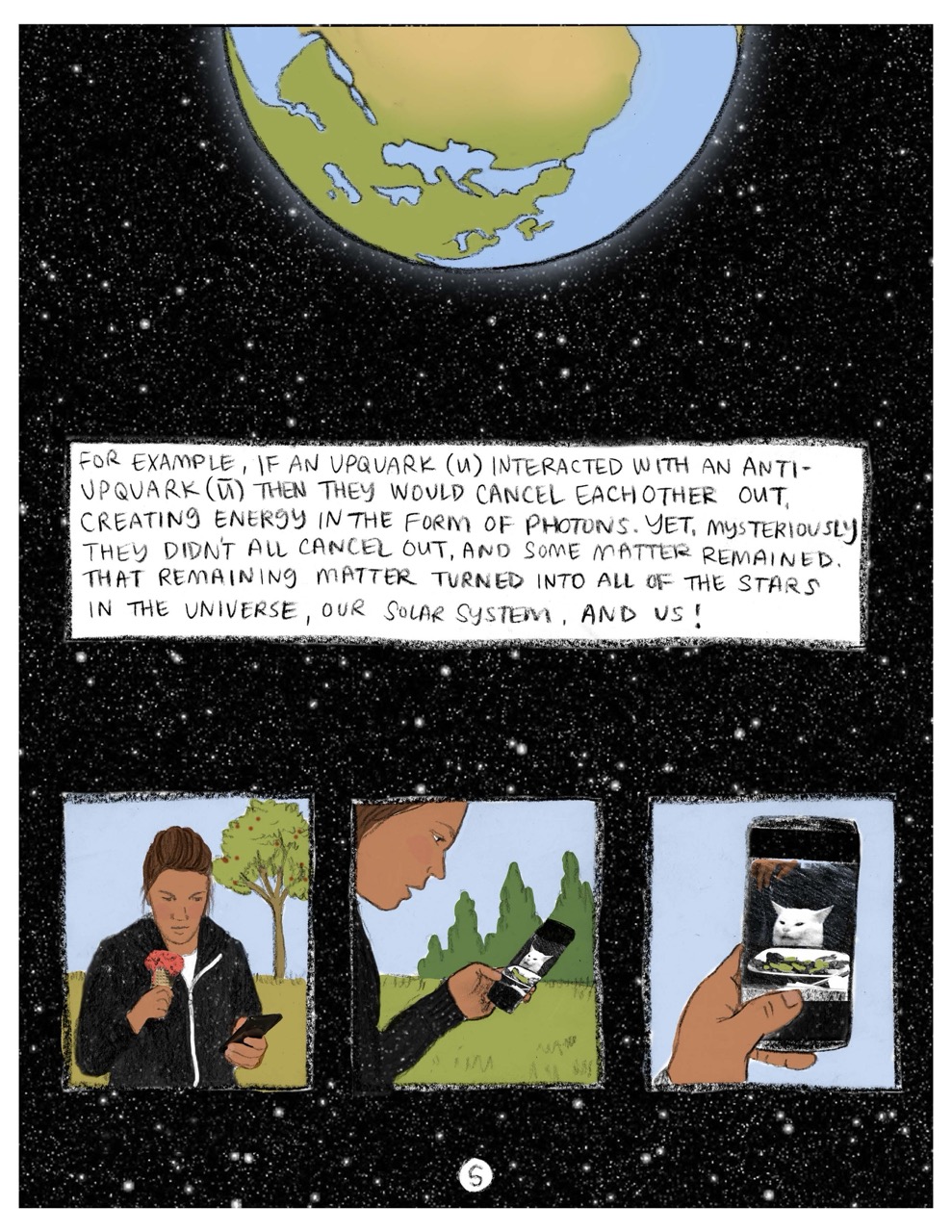
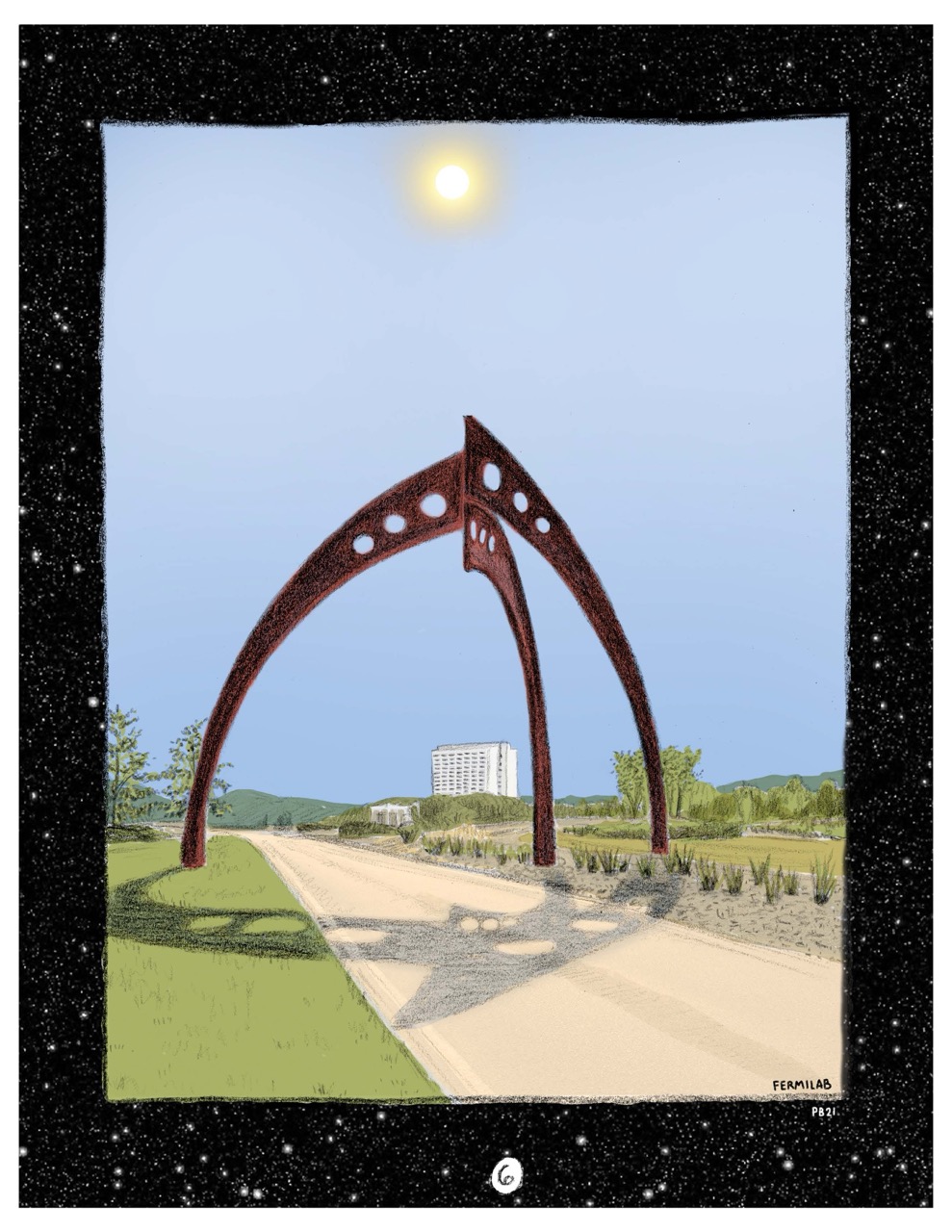
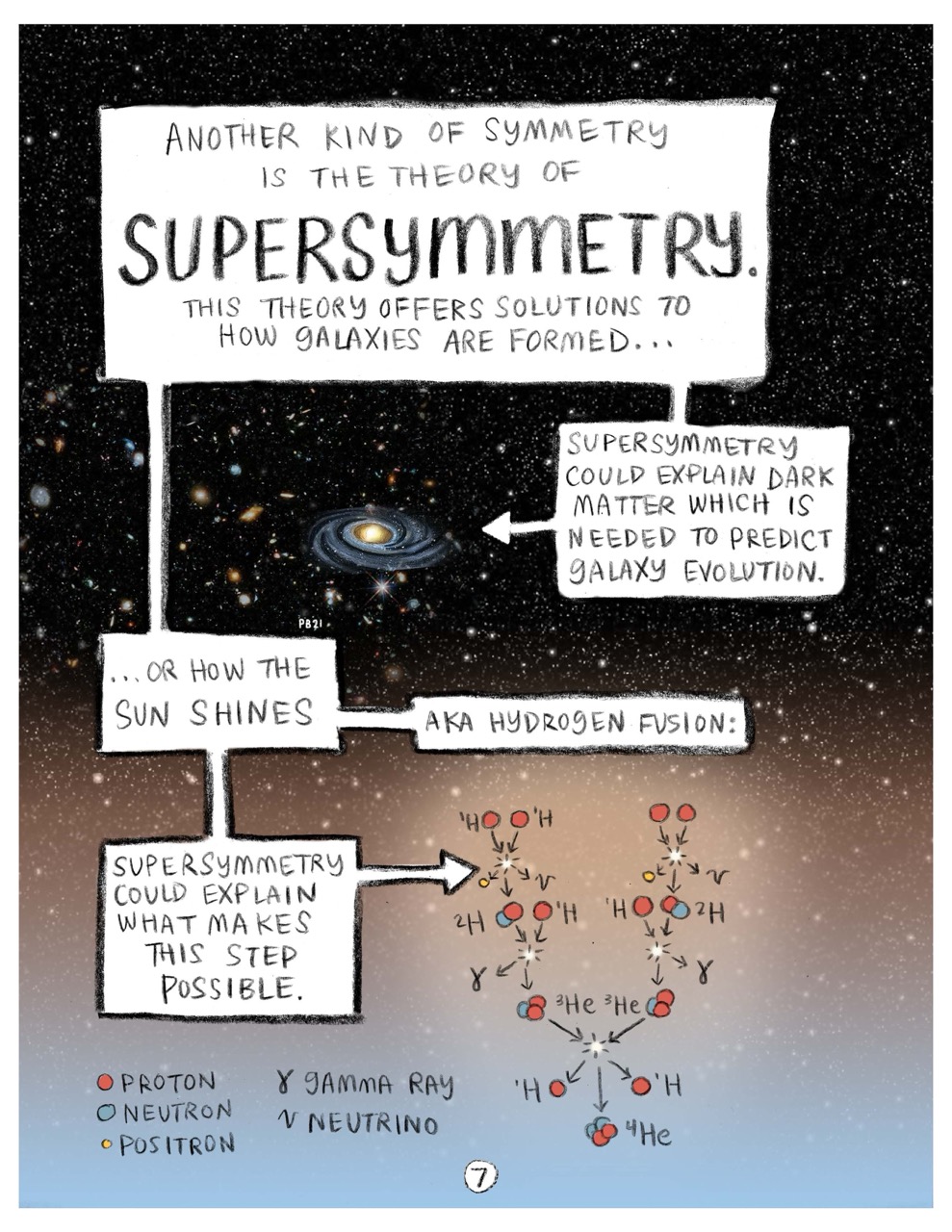
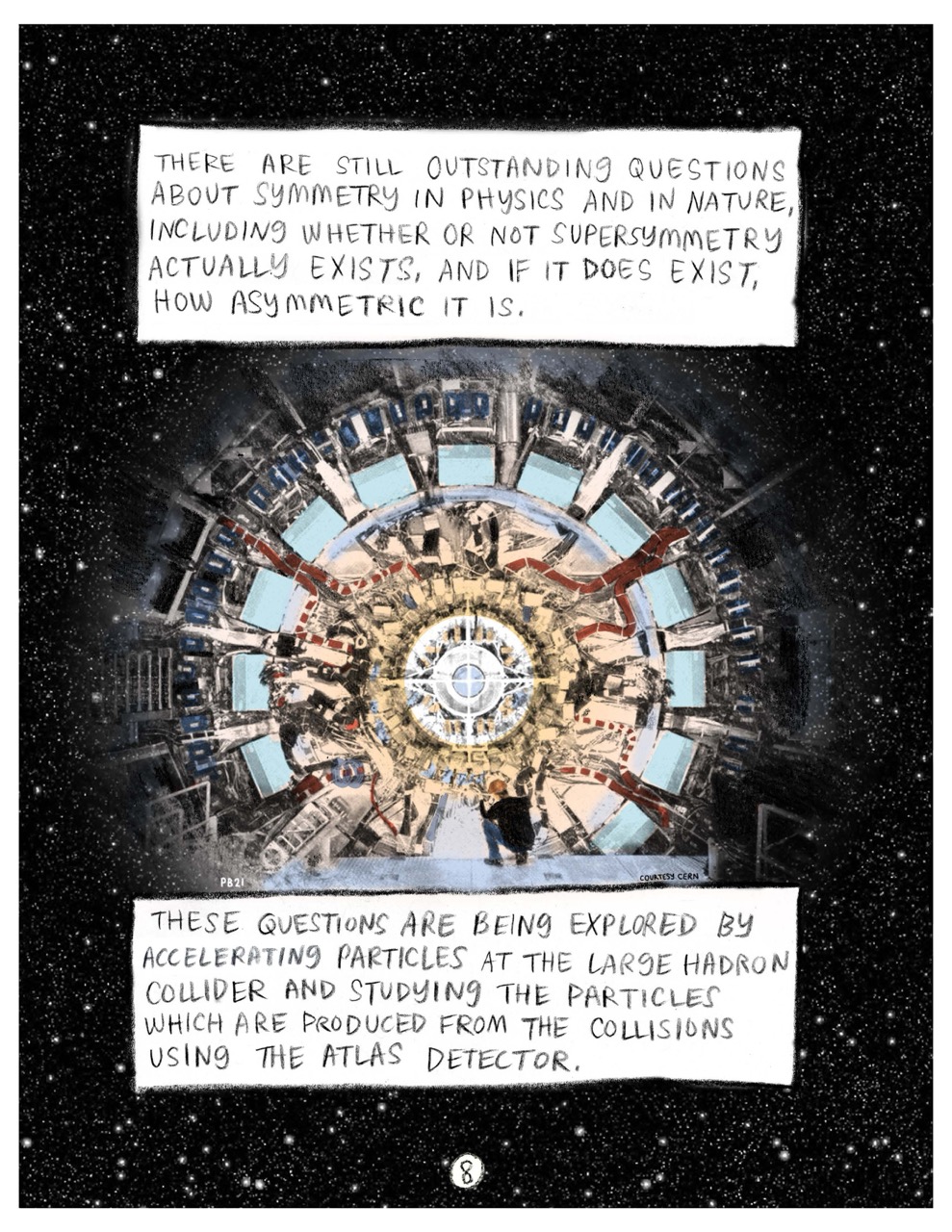
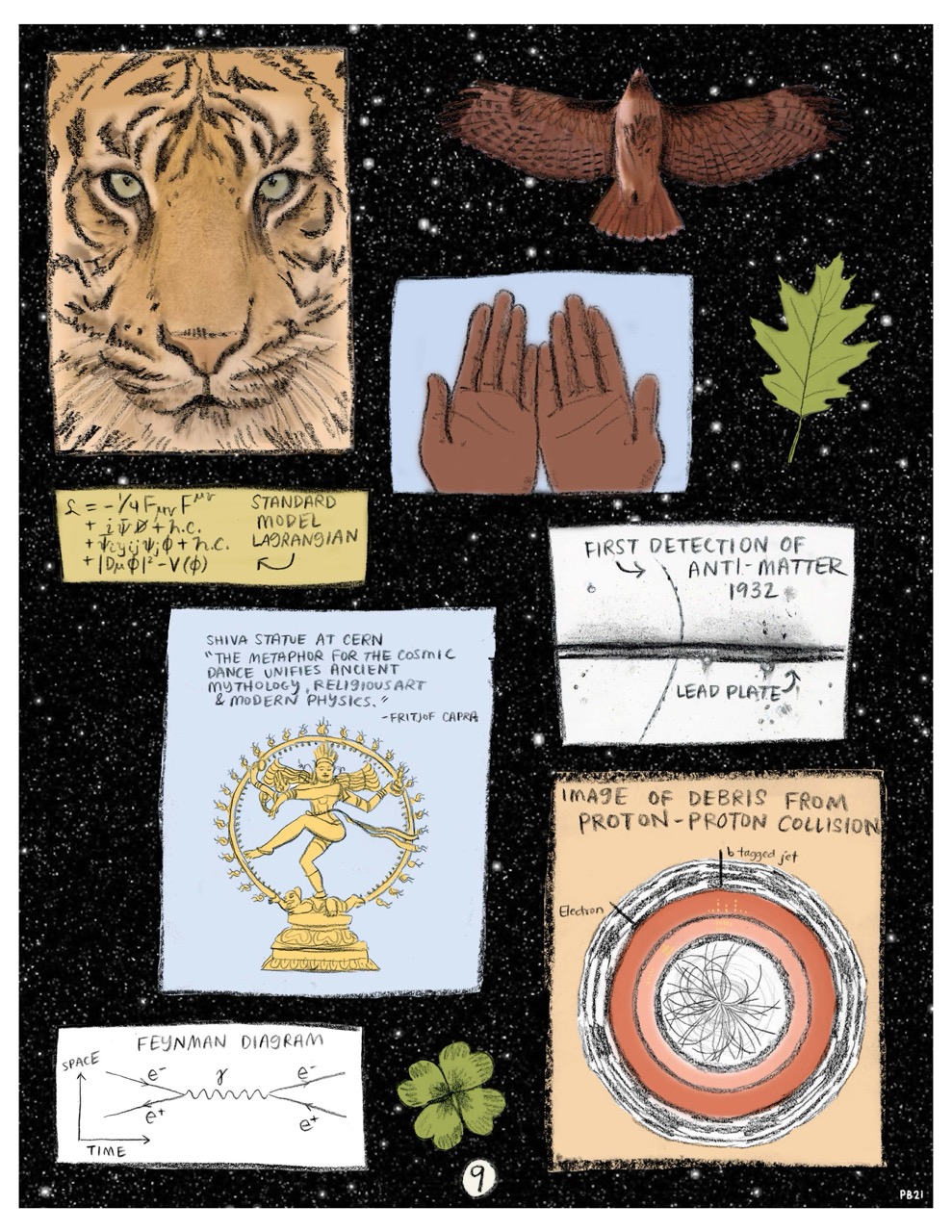
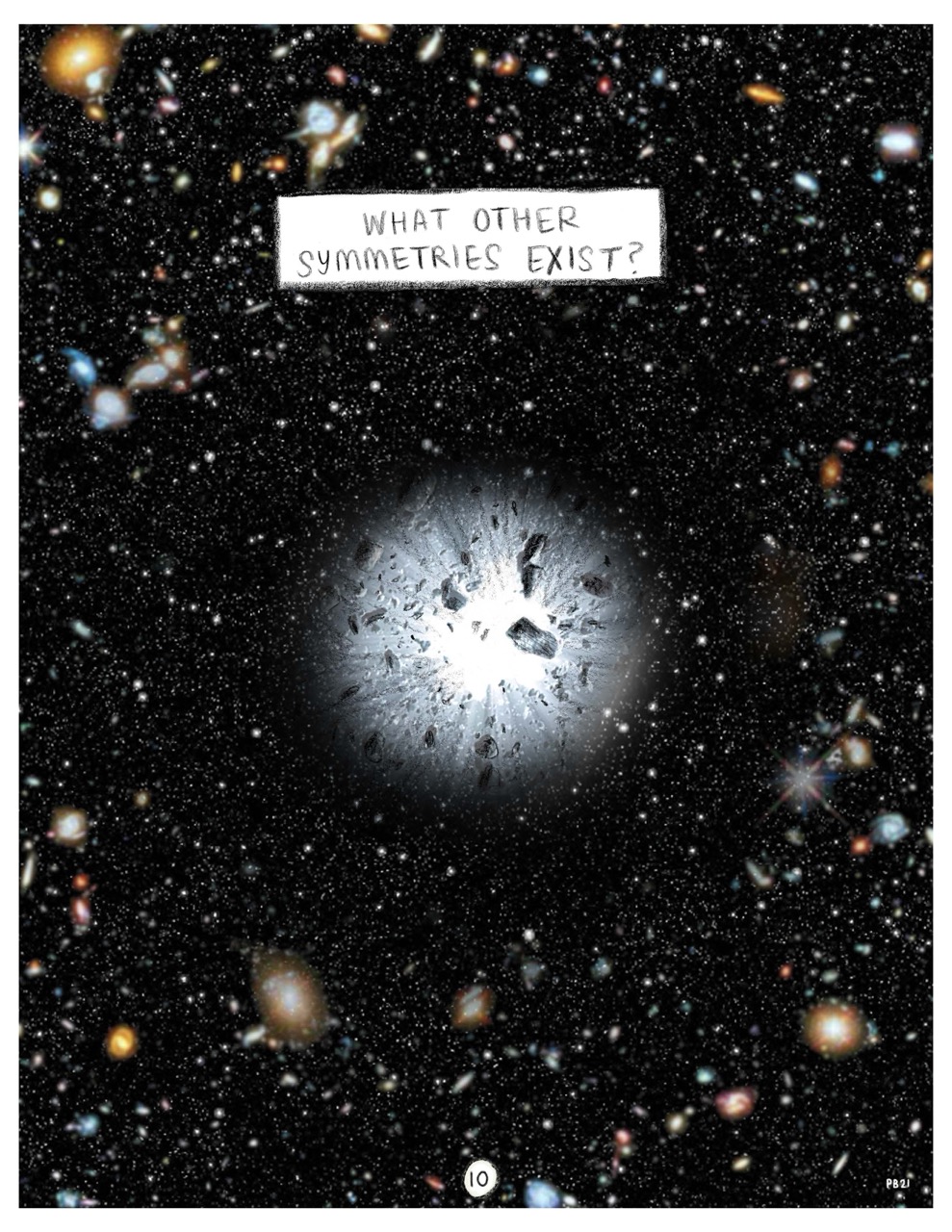
Transcript
Overview
A beautifully hand drawn and hand lettered comic. The art is detailed and done in textured pencil. The colors and backgrounds of the pages are digital. Most backgrounds are photographs of deep space stars. The text in this comic is all narration. All text that appears in the comic is transcribed in quotes. The text in the comic is in all caps, but is transcribed in sentence case.
Cover
Symmetry in Physics
By Page Biersdorff & Dr. Laura Jeanty
Created through the University of Oregon: Comics & Science fellowship program.
The background of the cover is the blackness of space covered with tiny white stars (dots in various sizes). The title and authors are written in a white box in the center of the page, along with a hand drawn monarch butterfly with symmetrical wings.
Page 1
Like the cover, the background of the page is space, a black background with tiny white stars.
Panel 1: “Many kinds of symmetry are found in nature. For example: the translational symmetry of honeycombs.” A honeybee crawls across a honeycomb, made of symmetrical hexagons.
Panel 2: “Or the bilateral symmetry of horned beetles.” Three large black beetles, seen from above, that are symmetrical across their vertical axes.
Panel 3: “or the Milky Way’s rotational symmetry.” A bleed panel, the swirling milky way galaxy against the background of space. The center of the galaxy is a bright glow, and solar systems rotate around it.
“Do symmetries exist at the scale of…”
Panel 4: “The universe?” A zoomed out view of the universe, showing hundreds of galaxies.
Panel 5: “Or atoms?” A diagram of an atom, with electrons rotating around the central nucleus in valence shells.
Panel 6: “Or the fundamental particles which make up atoms and everything else?”
Page 2
A page with two vertical panels. The panels are mostly symmetrical, reflected across the vertical center of the page.
“Physicists find symmetry in the laws of nature which describe fundamental interactions. There are different forms of symmetry in physics…A form of exact symmetry is found in the laws of nature as we move through time.”
Panel 1: A young girl sits on a branch of an apple tree. The sun is bright in the sky and in the background are tree covered hills. The ground is littered with apples. The girl drops an apple from the tree and it falls towards the ground. “For example: the law of gravity is exactly the same whether this apple is dropped then…”
Panel 2: “or now.” Panel two is a reflection of panel one, but now it’s dark and the moon is in the sky. “The fact that physical laws stay constant as time passes is an exact symmetry.”
Page 3
The top third of the page is a night sky full of stars. This fades into a deep midnight blue, and eventually into a salmon sunset over Geneva, Switzerland. At the bottom of the page is a large dome shaped structure, with a geometric sculpture out front. A sign indicates ‘CERN.’
Panel 1: “Through symmetry we determined that every particle has an antimatter mirror self (called charge parity (CP) symmetry.)”
Panel 2: “The particle/anti-particle pairs behave almost identically, but not quite, so this symmetry is considered broken or asymmetric.”
In the night-sky background 3 birds fly past the panels. One says: “what a paradox!”
Panel 3: a diagram showing matter, antimatter pairs. They have opposite charges. There are 17 matter particles and 17 antimatter particles, each represented by a colored square with a symbol on it, arranged in a 4 by 4 grid with a 5th particle in the top rows. Matter including protons, electrons, and hydrogen are included in te diagram.
Panel 4: a graph labeled “CP Violation.” There are two bell curves on the graph that are slightly misaligned. This misalignment is labeled “asymmetry.”
Panel 5: “Our entire existence depends on exact symmetries as well as asymmetries…” An arrow at the bottom of this panel points to the next page.
Page 4
“If Symmetry between matter and anti-matter were not slightly broken or asymmetrical, then all of matter would have been annihilated by anti-matter after the Big Bang.”
The entire page is covered in the same space background from previous pages. In the center of the page is a huge explosion of white light and fragments of metallic elements.
Page 5
The background of the page is space, full of stars. At the top of the page, not within a panel, half of the planet earth is visible.
“For example, if an upquark (u) interacted with an anti-upquark (ū) then they would cancel each other out, creating energy in the form of photons. Yet, mysteriously they didn’t all cancel out, and some matter remained. That remaining matter turned into all of the stars in the universe, our solar system, and us!
Panel 1: A woman in a hoodie holds a dripping ice cream cone and looks at her phone.
Panel 2: The woman turns so her phone screen is visible.
Panel 3: A close-up on the phone, showing a meme of a confused looking white cat with its ears pointing out in a triangle sitting in front of a plate of vegetables.
Page 6
A full-page panel with no text. A completely clear day with the sun high in the sky. A walking path starts in the foreground and stretches into the distance. On either side of the walking path are manicured lawns and landscaped plants. In the deep background there are low rolling hills and a 10-20 story building. The tall metal sculpture “Broken Symmetry” straddles the walking path with its three legs. Each leg is a curved metal panel that is wider at the top, where they meet. There are three round holes near the top of each leg. The sculpture casts a shadow over the path. “FERMILAB”
The background of the page is space, filled with stars.
Page 7
The background of the page is space. Near the top of the page the space is full of stars, towards the middle the space is full of small galaxies, the blackness of space transforms to a light brown haze and eventually transitions to a light sky-blue.
Text box 1: “Another kind of symmetry is the theory of supersymmetry [emphasis]. This theory offers solutions to how galaxies are formed…”
Text box 2: “supersymmetry could explain dark matter which is needed to predict galaxy evolution.” An arrow on the side of this text box points to a galaxy that is larger than the other galaxy’s in the page background.
Textbox 3: “…or how the sun shines, aka hydrogen fusion:”
A diagram of hydrogen fusion: 4 protons are converted into one helium nucleus (the center of an atom, without the electrons). As this conversion process happens energy, positrons and neutrinos are released.
- First, two protons combine, energy, a neutrino and a positron are released. One of the protons turns into a neutron, and the proton neutron pair form the nucleus of deuterium (a heavy isotope of hydrogen).
- Next another proton combines with the deuterium to form the light helium isotope (helium -3), energy and a gamma ray are released.
- Steps 1 and 2 happen twice (ie 6 protons are converted into two helium -3 isotopes).
- The two helium -3 nuclei combine and form helium -4, this releases 2 protons and more energy.
“Supersymmetry could explain what makes [step 1: combining the first two protons] possible.”
Page 8
“There are still outstanding questions about symmetry in physics and in nature, including whether or not supersymmetry actually exists, and if it does exist, how asymmetric it is.”
A full-page abstract drawing of a head-on view of a CERN Large Hadron Collider. The collider is a giant machine shaped like a circle. It has a huge ring of magnets that surround a long tunnel, the accelerator, where particle beams collide. There are lots of support structures that surround the accelerator. A man in a hard hat kneels in front of the conductor, possibly doing maintenance. He is about 1/10th as tall as the superconductor while kneeling. At the edges of the collider the image fades into the space background.
“These questions are being explored by accelerating particles at the Large Hadron Collider and studying the particles where are produced from the collisions using the Atlas Detector.”
Page 9
Panel 1: A close up on the face of a tiger. Its stripes are symmetrical.
Panel 2: a hawk, seen from below, with its wings spread.
Panel 3: a person’s hands opened like a book, so they are reflectively symmetrical
Panel 4: a single green oak leaf.
Panel 5: a complex math equation “Standard model Lagrangian”
Panel 6: “First detection of anti-matter 1932” a black and white pencil drawing of a lead plate with a slash through it and lots of smudgy circles.
Panel 7: “Shiva statue at CERN ‘the metaphor for the cosmic dance unifies ancient mythology, religious art & modern physics.’ – Fritjof Capra” A gold Nataraja statue depicting Shiva dancing inside a decorated ring. Shiva has four arms. Two of them reach out to the side to touch the inside of the ring. Shiva’s other two arms meet in front of his body. One of his legs is raised and pointed to the side.
Panel 8: “Image of debris from proton-proton collision.” Interior of Atlas Detector, which has two outer rings on which are faint dots that show two “jets” from the collision. One is labeled “electron,” the other is the “b tagged jet” Inside the rings are many particle tracks, illustrated as lines originating from the center and pointing in every direction.
Panel 9: “Feynman Diagram” To the left there is a small X,Y axes y = space, x = time. The diagram is symmetrical. On the left is an arrow in labeled ‘e-’ (electron) and an arrow out labeled ‘e+’(positron). On the right is an arrow out ‘e-’ and an arrow in ‘e+’. Between the two sets of arrows is a sine wave representing a photon.
Panel 10: a four leaf clover.
Page 10
“What other symmetries exist?”
The background of the page is space, filled with both galaxies and stars. In the center of the page is an explosion of white light and chunks of metal.

